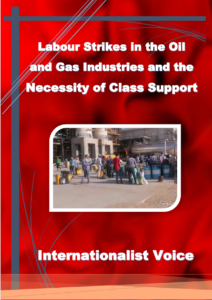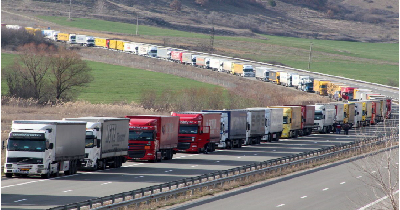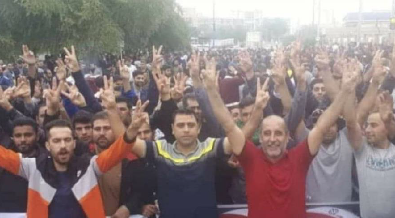Labour Strikes in the Oil and Gas Industries and the Necessity of Class Support
The new round of protests and labour strikes by project workers, contractors and temporary employees in the oil and gas industries due to their unanswered demands started again on 20 June 2024 in the Dasht Abbas and Samin companies and quickly spread to others. Thousands of workers were involved who protested and went on strike. The struggles of project workers and the third pillars of oil and gas in defence of their standard of living as well as their job security go back to previous years.[1] During recent protests, the workers not only did not achieve their demands, but the living conditions of the wage slaves became more difficult than before, and this issue prepared the material grounds for the new wave of labour strikes and protests.
The main demands of the contract and project workers are 14 days of work and 14 days of rest, as well as the elimination of contractors and an increase in wages. Currently, contract workers work 22 days a month in deplorable working conditions away from their homes, and only have eight days of rest during which to visit their families. Of course, part of this is also spent commuting, which means that in reality the resting period is less than eight days. In the oil and gas industry, thousands of workers are employed through contracting companies with temporary contracts, and compared to the official workers of the Ministry of Oil, they receive lower wages and fewer welfare benefits.
In recent decades, the Islamic bourgeoisie has implemented a policy aimed at destroying the union of workers by handing over various sectors of industries, especially the oil one, to contractor companies and creating numerous employers. Contracting companies play a big role in concluding slave-like contracts with uncertain job security and low benefits, and in the last decade, most of the oil and gas workers of contracting companies have been given such contracts.
In recent years, workers around the world are no longer willing to pay the cost of the capitalist crisis through the fall of their living standards, as before, and are raising their heads. In such a situation, the strikes by thousands of workers are very important in the crucial sector of the oil and gas industry, and have spread to many companies.
The basic question that is raised is, despite the widespread labour protests and strikes, why have the achievements been insignificant? The suppression of labour protests by the bourgeois government and employers, in the form of either direct suppression[2] or blacklisting, is one of the factors. In addition, despite the glory and heroism of the current protests and strikes, they also have weaknesses, of which a few can be mentioned.
Although labour strikes in the oil and gas industry have spread to most regions, the strikes lack internal class solidarity. The disintegration of workers’ protests and strikes, combined with the lack of coordination between them, is one of the main weaknesses. Strikes occur separately and have no connection with other protests and therefore the working class is not able to appear as a social class.
Legalism, directing workers’ protests and strikes to legal and governmental channels, and the venting of workers’ class anger are some of the dangers that threaten strikes. Some want to limit the strikes and protests of workers simply by forcing workers to leave their place of work and sending them home. A strike does not merely interrupt work; it curtails the production of added value. Striking workers must stay in their dormitories and play an active role in decision-making and in advancing the protests.
Workers have gained experience from independent public assemblies, protests and strikes of past years. It is vital to refer to this tradition and to make decisions about the process of campaigns through public assemblies, in which workers gain confidence in collective power and shape the future of action collectively through passion and consultation.
It is particularly important to form strike committees that can implement the decisions of general assemblies and can establish genuine class unity by communicating with other sisters and brothers. In protests, we can only rely on our class power and that of our fellow comrades. The absence of a strike fund means that strike committees can facilitate mutual aid from different groups.
The chained workers!
Defence and solidarity with labour strikes are not only the defence of the demands of the working class, but contain the seeds of social revolution. Due to their anti-capitalist nature, labour strikes can spread to other capitalist countries and stimulate class solidarity of their workers, while also challenging the capitalist state.
Long live the class unity of the working class!
The future belongs to the class struggle!
M. Jahangiry
22 June 2024
Notes:
[1] The article “A New Wave of Strikes and Workers’ Protests – Long Live the Independent Workers’ Struggle!” analyses and reviews the strikes of 2021.
[2] In support of the contracting companies, the security forces have sent threatening text messages (SMS) to the protesting workers, warning them about launching strikes and disrupting the production process, which could result in legal prosecution.















